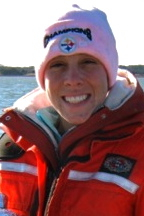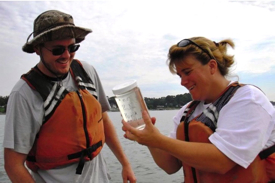Best Student Paper Awards
Each year a committee of faculty and students undertakes the difficult task of choosing the best journal articles from the many high-quality papers written by VIMS graduate students. Each paper considered is either accepted, in press, or published in a high-quality, peer-reviewed journal. The papers reflect the superb quality of the research conducted by VIMS students and the outstanding mentoring of their advisors. Papers are judged for the scope of problem, degree of challenge, magnitude of student’s effort, hypothesis formulation and testing, and writing style.
The committee, which this year included Kam Tang, Richard Brill, John Milliman, Jennifer Martin, and Ryan Carnegie, evaluated 10 papers in both the Ph.D. and Master’s categories.
Master's
 This year’s choice for the best paper by a Master’s student
goes to Juliette Giordano for “Quantifying
annual nitrogen loads to Virginia’s coastal lagoons: sources and water quality
response.” Her paper appeared in Estuaries
and Coasts and was co-authored by Mark Brush and Iris Anderson.
This year’s choice for the best paper by a Master’s student
goes to Juliette Giordano for “Quantifying
annual nitrogen loads to Virginia’s coastal lagoons: sources and water quality
response.” Her paper appeared in Estuaries
and Coasts and was co-authored by Mark Brush and Iris Anderson.
The coastal lagoons of the Delmarva Peninsula have long been considered to lie along a gradient of nutrient loading, with elevated loads to the north due to agriculture and intensive development and low loads in more rural Virginia. However, estimates of loads in Virginia are largely unavailable to confirm this pattern. In this paper, Juliette predicted the likely response of lagoon water quality to changes in development and loading. She conducted her work in collaboration with Accomack County, which incorporated her results into its 2008 Comprehensive Plan update.
Ph.D.
 The most meritorious student author in the PhD category is David
Elliott for “Dead in the Water: The fate
of copepod carcasses in the York River estuary, Virginia.” David’s paper
appeared in Limnology & Oceanography
and was co-authored by Courtney Harris and Kam Tang.
The most meritorious student author in the PhD category is David
Elliott for “Dead in the Water: The fate
of copepod carcasses in the York River estuary, Virginia.” David’s paper
appeared in Limnology & Oceanography
and was co-authored by Courtney Harris and Kam Tang.
Mortality is the most poorly constrained parameter in models of zooplankton population dynamics. Using a staining method that he improved, David discovered that there were a substantial number of dead copepods in the York River estuary. He used a combination of field observations, laboratory experiments, and mathematical modeling to investigate the fate of copepod carcasses due to sedimentation, coprophagy, and microbial decomposition.
The results will help researchers estimate an in situ mortality rate, both due to predation and other factors, and construct more realistic models of population dynamics. David’s work will likely fundamentally change our understanding of marine zooplankton ecology.
The submitted papers once again demonstrate the high quality and broad reach of our students’ work.
Congratulations, Juliette and David.

